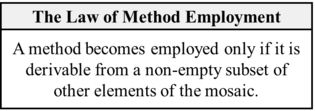The Law of Method Employment (Rawleigh-2022)
This is an answer to the question Mechanism of Method Employment that states "A method becomes employed only if it is derivable from a non-empty subset of other elements of the mosaic."
The Law of Method Employment was formulated by William Rawleigh in 2022.1 It is currently accepted by Scientonomy community as the best available answer to the question.
Contents
Scientonomic History
Acceptance Record
| Community | Accepted From | Acceptance Indicators | Still Accepted | Accepted Until | Rejection Indicators |
|---|---|---|---|---|---|
| Scientonomy | 21 February 2024 | The law became accepted as a result of the acceptance of the respective modification. | Yes |
Suggestions To Accept
Here are all the modifications where the acceptance of this theory has been suggested:
| Modification | Community | Date Suggested | Summary | Date Assessed | Verdict | Verdict Rationale |
|---|---|---|---|---|---|---|
| Sciento-2022-0002 | Scientonomy | 28 February 2022 | Accept the new law of norm employment that fixes some of the issues of the current law of method employment and makes it applicable to norms of all types. | 21 February 2024 | Accepted | Prior to the 2024 workshop, Hakob Barseghyan commented on the encyclopedia with his opinion that the modification should be accepted given that the formulation seemed relatively future-proof: it would not have to change even if more elements are included into our ontology. Paul Patton and Cameron Scott raised some concerns about the differences between norm employment and norm acceptance, and about the derivability of norms from agents’ mosaics, given cases in the history of science where agents accept a norm that is derivable from their mosaic but do not act accordingly (that is, they fail to employ the norm). However, it was noted that this is a separate issue from what the modification aims to do: the law of norm employment does not describe what happens to norms that are already present in the mosaic, but merely describes how norms come to be part of the mosaic. Yet, the discrepancy in the community’s accepted definitions of norm acceptance (as a subtype of theory acceptance) and norm employment was highlighted as a pertinent issue for later focus. After this clarification, there were no further issues raised, and the modification was accepted by over a two-thirds majority of voters. 14 out of 16 votes were for acceptance. |
Question Answered
The Law of Method Employment (Rawleigh-2022) is an attempt to answer the following question: How do methods become employed by an epistemic agent?
See Mechanism of Method Employment for more details.
Description
This law of method employment is a corollary of Rawleigh's law of norm employment. It implies that, just like the norms of all other types, methods become employed when they are derivable from other elements of the agent's mosaic (such as other theories, other methods, and perhaps even questions). As such, the law preserves most of the content of Sebastien's third law by solving some of the issues inherent in it.
See The Law of Norm Employment (Rawleigh-2022) for a more thorough exposition.
Reasons
No reasons are indicated for this theory.
If a reason supporting this theory is missing, please add it here.
Questions About This Theory
There are no higher-order questions concerning this theory.
If a question about this theory is missing, please add it here.
References
- ^ Rawleigh, William. (2022) Reconceiving Scientific Mosaics: A New Formalization for Theoretical Scientonomy. In Barseghyan et al. (Eds.) (2022), 83-103.
